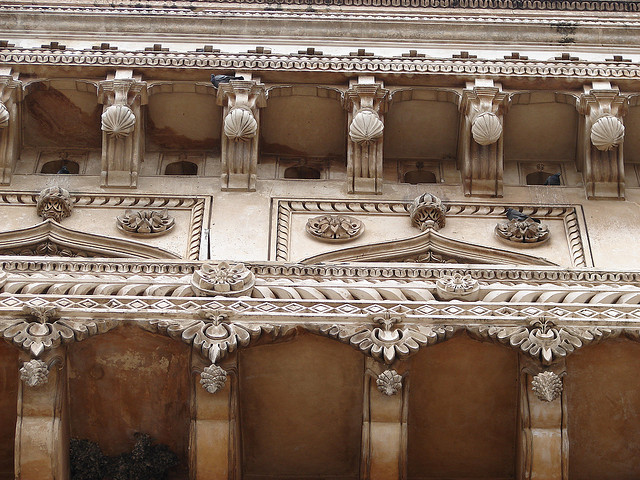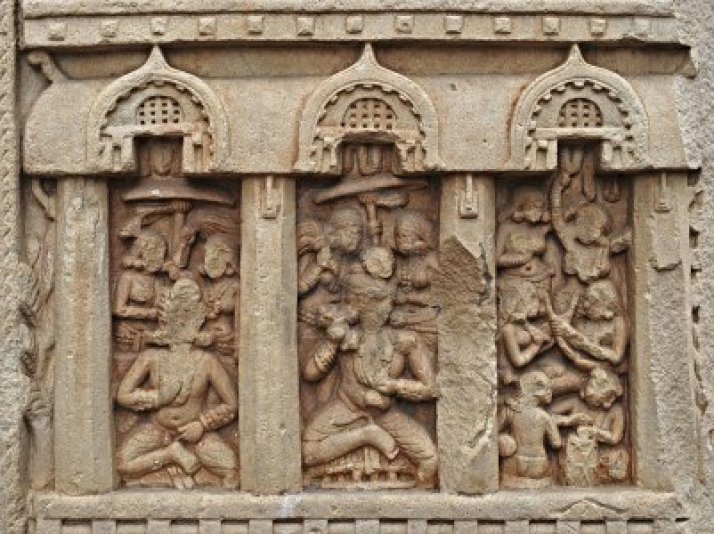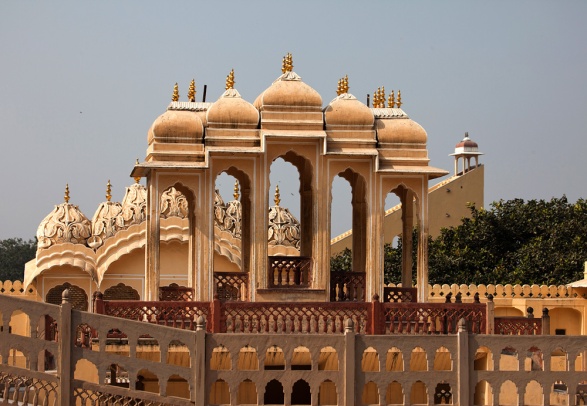Vedic Age
Duration: 1500 BC to 500 BC
The Vedic Period or the Vedic Age refers to that time period when the Vedic Sanskrit texts were composed in India. The society that emerged during that time is known as the Vedic Period, or the Vedic Age, Civilization. The Vedic Civilization flourished between the 1500 BC and 500 BC on the Indo-Gangetic Plains of the Indian subcontinent. This civilization laid down the foundation of Hinduism as well as the associated Indian culture. The Vedic Age was followed by the golden age of Hinduism and classical Sanskrit literature, the Maurya Empire and the Middle Kingdoms of India.
Vedic Texts
Linguistically, the texts belonging to the Hindu Vedic Civilisation can be classified into the following five chronological branches:
Rigvedic
The oldest text of the Vedic Period, Rig Veda has many elements that are common with the Indo-Iranian texts, both in language and in content. One cannot find such similarity in any other Vedic text. It is believed that the compilation of the Rig Veda had stretched over a number of centuries. However, there is a conflict as to the completion date of the Rig Veda. Some historians believe it to be 1500 BC, while the others believe it to be 3000 BC. This time period coincided with the Indus Valley Civilization.
Mantra Language
The period of the Mantra Language includes the time of the compilation of the mantra and prose language of the Atharvaveda (Paippalada and Shaunakiya), the Rigveda Khilani, the Samaveda Samhita and the mantras of the Yajurveda. Though derived from the Rig Veda, all these texts experienced wide scale changes, in terms of language as well as at the time of reinterpretation. This time period coincided with the early Iron Age in northwestern India and the Black and Red Ware culture.
Samhita Prose
The period of Samhita Prose represents the compilation and codification of a Vedic canon. The linguistic changes of this time include the complete loss of the injunctive, the subjunctive and the aorist. The commentary part of the Yajurveda belongs to the Samhita Prose period. During this time, the Painted Grey Ware culture was evident.
Brahmana Prose
This period signifies Brahmanas proper of the four Vedas, along with the oldest Upanishads.
Sutra Language
The last division of the Vedic Sanskrit can be traced upto 500 BC. During this time, a major portion of the Srauta Sutras, the Grihya Sutras and some Upanishads were composed.
Epic and Paninian Sanskrit (Post Vedic)
In the post-Vedic Period, the compilation of Mahabharata and Ramayana epics took place. The Classical Sanskrit described by Panini also emerged after the Vedic Age. The Vedanta and the Pali Prakrit dialect of Buddhist scripture belong to this period. During this time, the Northern Black Polished Ware culture started spreading over the northern parts of India.
The end of the Vedic Period Civilization in India was marked by significant changes in the field of linguistics, culture and politics. With the invasion of the Indus valley by Darius I, in the 6th century, outside influences started creeping in.
Early Vedic Period (Rigvedic Period)
The Rigvedic Period represents the time period when the Rig Veda was composed. The Rig Veda comprises of religious hymns, and allusions to various myths and stories. Some of the books even contain elements from the pre-Vedic, common Indo-Iranian society. Some similarities are also found with the Andronovo culture and the Mittanni kingdoms. Thus, it is difficult to define the exact beginning of the Rigvedic period. The prominent features of the Rigvedic period are given below:
Political Organization
The political units during the Rigvedic or the early Vedic period comprised of Grama (village), Vish and Jana. The biggest political unit was that of Jana, after which came Vish and then, Grama. The leader of a Grama was called Gramani, of a Vish was called Vishpati and that of Jana was known as Jyeshta. The rashtra (state) was governed by a Rajan (King) and he was known as Gopa (protector) and Samrat (supreme ruler). The king ruled with the consent and approval of the people. There were four councils, namely Sabha, Samiti, Vidhata and Gana, of which women were allowed to attend only two, Sabha and Vidhata. The duty of the king was to protect the tribe, in which he was assisted by the Purohita (chaplain) and the Senani (army chief).
Society and Economy
Numerous social changes took place during the early Vedic period. The concept of Varna, along with the rules of marriage, was made quite stiff. Social stratification took place, with the Brahmins and the Kshatriyas being considered higher than the Shudras and the Vaisyas. Cows and bulls were accorded religious significance. The importance of agriculture started growing. The families became patriarchal and people began praying for the birth of a son.
Vedic Religious Practices
Rishis, composers of the hymns of the Rig Veda, were considered to be divine. Sacrifices and chanting of verses started gaining significance as the principal mode of worship. The main deities were Indra, Agni (the sacrificial fire), and Soma. People also worshipped Mitra-Varuna, Surya (Sun), Vayu (wind), Usha (dawn), Prithvi (Earth) and Aditi (the mother of gods). Yoga and Vedanta became the basic elements of the religion.
Later Vedic Period
The later Vedic Period commenced with the emergence of agriculture as the principal economic activity. Along with that, a declining trend was experienced as far as the importance of cattle rearing was concerned. Land and its protection started gaining significance and as a result, several large kingdoms arose.
Political Organization
The rise of sixteen Mahajanapadas, along with the increasing powers of the King, comprise of the other characteristics of this period. Rituals like rajasuya, (royal consecration), vajapeya (chariot race) and ashvamedha (horse sacrifice) became widespread. At the same time, the say of the people in the administration diminished.
Society
As far as the society is concerned, the concept of Varna and the rules of marriage became much more rigid than before. The status of the Brahmanas and Kshatriyas increased greatly and social mobility was totally restricted. The proper pronunciation of verses became to be considered as essential for prosperity and success in war. Kshatriyas started amassing wealth and started utilizing the services of the Brahmins. The other castes were slowly degraded. Around 500 BC, the later Vedic Period started giving rise to the period of the Middle kingdoms of India.
The Vedic Period or the Vedic Age refers to that time period when the Vedic Sanskrit texts were composed in India. The society that emerged during that time is known as the Vedic Period, or the Vedic Age, Civilization. The Vedic Civilization flourished between the 1500 BC and 500 BC on the Indo-Gangetic Plains of the Indian subcontinent. This civilization laid down the foundation of Hinduism as well as the associated Indian culture. The Vedic Age was followed by the golden age of Hinduism and classical Sanskrit literature, the Maurya Empire and the Middle Kingdoms of India.
Vedic Texts
Linguistically, the texts belonging to the Hindu Vedic Civilisation can be classified into the following five chronological branches:
Rigvedic
The oldest text of the Vedic Period, Rig Veda has many elements that are common with the Indo-Iranian texts, both in language and in content. One cannot find such similarity in any other Vedic text. It is believed that the compilation of the Rig Veda had stretched over a number of centuries. However, there is a conflict as to the completion date of the Rig Veda. Some historians believe it to be 1500 BC, while the others believe it to be 3000 BC. This time period coincided with the Indus Valley Civilization.
Mantra Language
The period of the Mantra Language includes the time of the compilation of the mantra and prose language of the Atharvaveda (Paippalada and Shaunakiya), the Rigveda Khilani, the Samaveda Samhita and the mantras of the Yajurveda. Though derived from the Rig Veda, all these texts experienced wide scale changes, in terms of language as well as at the time of reinterpretation. This time period coincided with the early Iron Age in northwestern India and the Black and Red Ware culture.
Samhita Prose
The period of Samhita Prose represents the compilation and codification of a Vedic canon. The linguistic changes of this time include the complete loss of the injunctive, the subjunctive and the aorist. The commentary part of the Yajurveda belongs to the Samhita Prose period. During this time, the Painted Grey Ware culture was evident.
Brahmana Prose
This period signifies Brahmanas proper of the four Vedas, along with the oldest Upanishads.
Sutra Language
The last division of the Vedic Sanskrit can be traced upto 500 BC. During this time, a major portion of the Srauta Sutras, the Grihya Sutras and some Upanishads were composed.
Epic and Paninian Sanskrit (Post Vedic)
In the post-Vedic Period, the compilation of Mahabharata and Ramayana epics took place. The Classical Sanskrit described by Panini also emerged after the Vedic Age. The Vedanta and the Pali Prakrit dialect of Buddhist scripture belong to this period. During this time, the Northern Black Polished Ware culture started spreading over the northern parts of India.
The end of the Vedic Period Civilization in India was marked by significant changes in the field of linguistics, culture and politics. With the invasion of the Indus valley by Darius I, in the 6th century, outside influences started creeping in.
Early Vedic Period (Rigvedic Period)
The Rigvedic Period represents the time period when the Rig Veda was composed. The Rig Veda comprises of religious hymns, and allusions to various myths and stories. Some of the books even contain elements from the pre-Vedic, common Indo-Iranian society. Some similarities are also found with the Andronovo culture and the Mittanni kingdoms. Thus, it is difficult to define the exact beginning of the Rigvedic period. The prominent features of the Rigvedic period are given below:
Political Organization
The political units during the Rigvedic or the early Vedic period comprised of Grama (village), Vish and Jana. The biggest political unit was that of Jana, after which came Vish and then, Grama. The leader of a Grama was called Gramani, of a Vish was called Vishpati and that of Jana was known as Jyeshta. The rashtra (state) was governed by a Rajan (King) and he was known as Gopa (protector) and Samrat (supreme ruler). The king ruled with the consent and approval of the people. There were four councils, namely Sabha, Samiti, Vidhata and Gana, of which women were allowed to attend only two, Sabha and Vidhata. The duty of the king was to protect the tribe, in which he was assisted by the Purohita (chaplain) and the Senani (army chief).
Society and Economy
Numerous social changes took place during the early Vedic period. The concept of Varna, along with the rules of marriage, was made quite stiff. Social stratification took place, with the Brahmins and the Kshatriyas being considered higher than the Shudras and the Vaisyas. Cows and bulls were accorded religious significance. The importance of agriculture started growing. The families became patriarchal and people began praying for the birth of a son.
Vedic Religious Practices
Rishis, composers of the hymns of the Rig Veda, were considered to be divine. Sacrifices and chanting of verses started gaining significance as the principal mode of worship. The main deities were Indra, Agni (the sacrificial fire), and Soma. People also worshipped Mitra-Varuna, Surya (Sun), Vayu (wind), Usha (dawn), Prithvi (Earth) and Aditi (the mother of gods). Yoga and Vedanta became the basic elements of the religion.
Later Vedic Period
The later Vedic Period commenced with the emergence of agriculture as the principal economic activity. Along with that, a declining trend was experienced as far as the importance of cattle rearing was concerned. Land and its protection started gaining significance and as a result, several large kingdoms arose.
Political Organization
The rise of sixteen Mahajanapadas, along with the increasing powers of the King, comprise of the other characteristics of this period. Rituals like rajasuya, (royal consecration), vajapeya (chariot race) and ashvamedha (horse sacrifice) became widespread. At the same time, the say of the people in the administration diminished.
Society
As far as the society is concerned, the concept of Varna and the rules of marriage became much more rigid than before. The status of the Brahmanas and Kshatriyas increased greatly and social mobility was totally restricted. The proper pronunciation of verses became to be considered as essential for prosperity and success in war. Kshatriyas started amassing wealth and started utilizing the services of the Brahmins. The other castes were slowly degraded. Around 500 BC, the later Vedic Period started giving rise to the period of the Middle kingdoms of India.





















.png)

